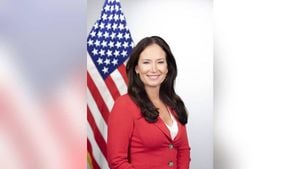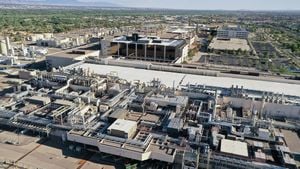Washington, D.C. — Less than two months before he officially takes office, President-elect Donald Trump faces immediate challenges concerning his presidential transition and cabinet selection process. With the clock ticking, concerns arise about the lack of signed transition agreements, which are pivotal for accessing government resources and intelligence briefings.
Political observers are raising alarms about the potential delays and stumbling blocks facing Trump's transition team. Historical precedence suggests early days of any presidency are often fraught with vulnerabilities, and the absence of necessary paperwork could leave incoming officials scrambling for information and support. The situation is compounded by Trump's recent wave of appointing senior staff and cabinet members, putting even more pressure on his team to secure the resources they need.
Despite announcing key picks for high-profile positions, Trump's team has yet to complete foundational agreements necessary for accessing federal offices. A memorandum of agreement with the current White House administration is still unsigned, leaving Trump's transition team without access to designated staff across federal agencies.
Kathryn Dunn Tenpas, a senior fellow at the University of Virginia’s Miller Center, emphasizes the importance of these agreements, declaring them “absolutely-critical.” According to Tenpas, any delays could lead to dire situations where the new administration cannot receive briefings, raising the stakes for the nation during this transitional phase. Historical instances of crises occurring early within administrations — such as the tragic events of 9/11 during George W. Bush’s presidency — serve as stark reminders of the importance of early preparations.
Transition experts indicate the Presidential Transition Act of 1963 outlines required procedures for this transfer of power. Typically, the General Services Administration (GSA) coordinates the process, and various agreements must be finalized by specific deadlines leading up to the inauguration date. With Trump’s transition team missing established timelines, questions linger on their preparedness once they move fully to power. Past transitions, including those of the Obama and Biden administrations, have illustrated the necessity for prompt and organized coordination.
Even with concerns surrounding the transition, Trump has swiftly begun filling key positions within his cabinet. His selections reflect continuity with his prior administration's approach, aiming to establish clear hard-right allegiances. Notable appointments include Susie Wiles as White House Chief of Staff, Elise Stefanik as the U.S. Ambassador to the United Nations, and Michael Waltz as National Security Adviser, demonstrating his commitment to his base and policy agenda from his first term.
Wiles has emerged as one of Trump’s trusted advisors, previously running his campaign operations and maintaining strong ties throughout the Biden administration. Trump described Wiles as “tough, smart, and innovative,” marking her historic role as the first female Chief of Staff. The choice signifies both personal trust and strategic alignment as he seeks to solidify his administration early.
Meanwhile, Trump has tapped military veteran and staunch Trump supporter Mike Waltz for national security. A decorated Army Green Beret, Waltz has positioned himself as a hard-liner on issues involving threats from countries like China and Iran.
Tom Homan, who previously directed U.S. Immigration and Customs Enforcement (ICE), has returned to serve as ‘Border Czar.’ Homan was known for his controversial zero-tolerance policy during Trump’s first term, putting him back on the frontline of the administration's immigration agenda. He embodies Trump's tough stance on immigration, aiming to reimplement policies aimed at reducing illegal immigration and tightening border security.
Further aligning his administration with key hard-right figures, Trump has appointed Stephen Miller, another long-time advisor, as Deputy Chief of Policy. This strategic choice signals Trump's intent to resurrect tough immigration policies and maintain loyalty within his ranks.
The speed at which Trump is announcing appointments reflects his urgency to establish control over the administrative narrative. Yet, it also lays bare the risks of attempting to do so without foundational agreements signed — increases the pressure on his team for efficacy and access once they assume their roles.
Critics from the Democratic party are voicing concerns about the strong ties between Trump's picks and their alignment to Project 2025, which some perceive to represent extreme conservative principles. This initiative advocates for significant changes to federal structures and seeks to impose policies centered around bold conservativism.
Trump has publicly distanced himself from Project 2025, asserting the specifics of his cabinet selections are determined solely by his vision, rather than external influences. Yet he has populated key posts with individuals — like Russell Vought at the Office of Management and Budget (OMB) — directly associated with the contours of Project 2025.
Vought, who previously served as OMB director, is anticipated to push for fiscal reforms aligned with Trump's campaign proposals, potentially reshaping the executive's control over spending and federal operations. His past advocacy for broad presidential authority over congressional budget decisions revives discussions about executive overreach.
While Trump has positioned various individuals deeply entrenched within conservative movement ideology, critics highlight the risks of governance influenced by far-right perspectives. The ramifications for systems like veterans’ healthcare and Social Security are rising worries for many as the appointments come with the specter of significant policy shifts.
With his administration still reforming and transitioning, the broader narrative of Trump’s picks emphasizes continuity over change — and the country bristles with anticipation about what this means for national governance moving forward. Time will reveal if Trump’s bold selections will transform Washington or return the nation to the tumultuous waters experienced during his previous term.



